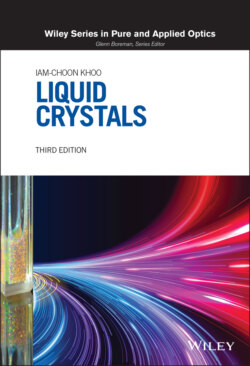Читать книгу Liquid Crystals - Iam-Choon Khoo - Страница 35
2.3. MOLECULAR THEORIES AND RESULTS FOR THE LIQUID CRYSTALLINE PHASE
ОглавлениеAmong the various theories developed to describe the order parameter and phase transitions in the liquid crystalline phase, the most popular and successful one is the theory first advanced by Maier and Saupe and corroborated in studies by others [8]. In this formalism, Coulombic intermolecular dipole–dipole interactions are assumed. The interaction energy of a molecule with its surroundings is then shown to be of the form [6]:
(2.11)
where V is the molar volume (V = M/p), S is the order parameter, and A is a constant determined by the transition moments of the molecules. Both V and S are functions of temperature. Comparing Eqs. (2.11) and (2.1) for the definition of S, we note that Wint ≈ S 2, so this mean‐field theory by Maier and Saupe is often referred to as the S 2 interaction theory [1]. This interaction energy is included in the free enthalpy per molecule (chemical potential) and is used in conjunction with an angular distribution function f(θ, ϕ) for statistical mechanics calculations.
